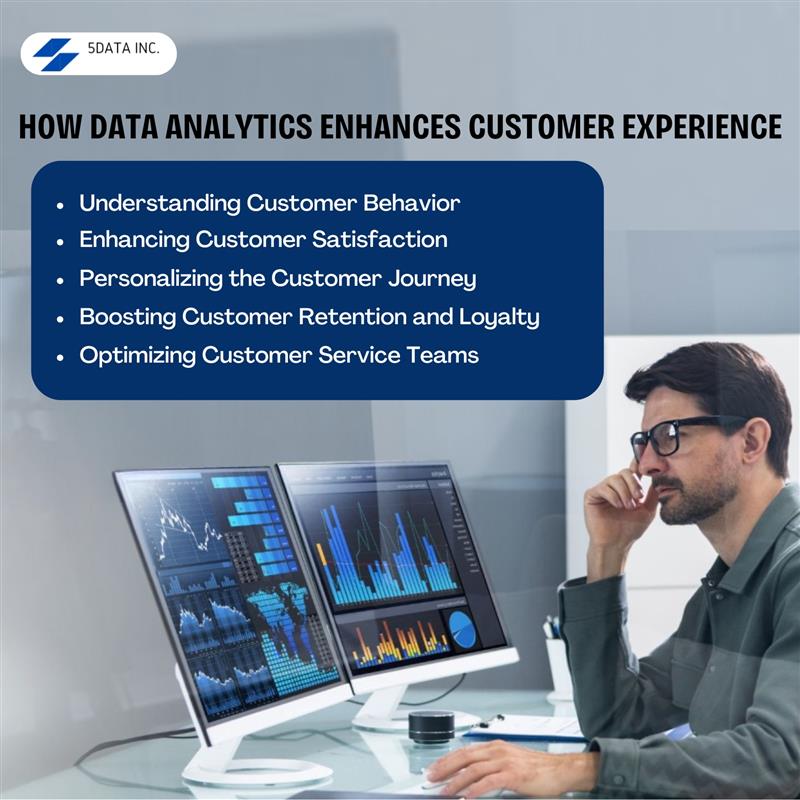Key Takeaways
- Data analytics helps understand behavior, address pain points, and personalize interactions to exceed customer expectations.
- Insights from churn and feedback enable proactive strategies like loyalty programs and personalized communication to foster long-term relationships.
- Analytics drives innovation, boosts engagement, and maximizes ROI through improved products and optimized customer experiences.
How Data Analytics Enhances Customer Experience
Understanding and improving customer relationships begins with effectively collecting customer data and analyzing it for valuable insights. By leveraging data analytics tools, businesses can delve into customer experience analytics, examining customer interaction and both direct feedback and indirect customer feedback. This process not only enhances data analysis but also empowers decision-makers to foster customer loyalty by addressing concerns highlighted through customer interactions. Ultimately, analyzing data enables companies to refine strategies and deliver exceptional experiences. Here are some specific ways data analytics can improve customer experience:
1. Understanding Customer Behavior
Understanding and predicting customer behavior is a key benefit of data analytics. By analyzing customer interaction data, businesses can identify patterns in how customers engage with products and services. This insight enables businesses to anticipate customer needs and tailor their offerings, staying ahead of customer expectations.
2. Enhancing Customer Satisfaction
Identifying and addressing customer pain points is a crucial aspect of data analytics. By collecting and analyzing direct customer feedback, such as reviews and surveys, and indirect feedback, as social media mentions, businesses can gain a comprehensive understanding of customer satisfaction. This diagnostic analytics approach helps businesses to proactively address issues and improve customer satisfaction, thereby enhancing retention.
3. Personalizing the Customer Journey
Personalizing the customer journey is another key function of data analytics. By collecting data on individual customer preferences and tracking the customer journey, businesses can offer personalized recommendations and experiences. This personalized approach, facilitated by customer analytics tools, ensures that every interaction feels relevant and meaningful to the customer.
4. Boosting Customer Retention and Loyalty
Customer retention is not just a result but a strategic goal closely linked to loyalty and satisfaction. Analyzing churn rates and customer service interactions helps businesses identify why customers leave and implement strategies to retain them. By leveraging customer data analytics, businesses can design loyalty programs that reward engagement and foster long-term relationships, thereby playing a crucial role in the business’s success.
5. Optimizing Customer Service Teams
Data-driven insights empower customer service teams to enhance their performance. By analyzing customer support interactions, teams can identify common issues, track key metrics, and improve response times. Tools like customer feedback analysis and satisfaction scores ensure continuous improvement.
Efficient data handling is crucial for modern businesses, making Data Collection and Data Management Service Providers indispensable. These providers offer specialized solutions to gather, organize, and maintain data, ensuring accuracy and accessibility for informed decision-making.
Importance of Data and Analytics
Data and analytics are critical in today’s customer-centric business environment. They provide actionable insights that drive decision-making and strategy. For example:
- Identifying Trends and Patterns: Businesses can leverage data to spot emerging patterns and adapt their offerings to meet evolving customer demands.
- Improving Business Growth: Data analytics insights can help businesses design strategies to enhance customer engagement and increase lifetime value.
- Driving Innovation: Analyzing customer choices and pain points inspires innovative solutions that elevate the customer experience. This role of data analytics in driving innovation can inspire businesses to think forward and stay ahead in the competitive market, making the audience feel inspired and forward-thinking. It makes the audience feel inspired and forward-thinking.
- Maximizing ROI: Optimized customer experiences lead to higher retention rates, lower acquisition costs, and increased revenue, making data analytics a cornerstone of business success.
Finding the Best software application development company is essential for businesses seeking innovative and reliable digital solutions. Such a company combines technical expertise and creativity to deliver custom applications that meet specific business needs, ensuring seamless functionality and customer satisfaction.

How Data Analytics Supports Retention Efforts
Customer experience analytics helps businesses gain insights by analyzing interactions and preferences, enabling better decisions and fostering personalized, engaging experiences. By prioritizing the systematic process of collecting data, organizations lay the foundation for creating personalized and engaging customer experiences.
- Understanding Churn Drivers: High customer churn can negatively impact revenue and growth. Data analytics identifies patterns that signal dissatisfaction, such as reduced engagement or negative feedback. By understanding these drivers, businesses can take corrective actions to retain customers.
- Enhancing Loyalty Programs: Customer lifetime value (CLV) analysis helps businesses segment customers based on profitability and loyalty. Analytics tools enable the design of targeted loyalty programs that reward repeat purchases and consistent engagement, boosting retention.
- Personalizing Communication: By leveraging customer data, businesses can send personalized messages, offers, and recommendations. This tailored approach ensures relevance, strengthening the bond between the brand and the customer.
- Proactive Issue Resolution: Analyzing historical data and feedback allows companies to predict future trends and potential issues before they arise. Proactively addressing these concerns builds trust and enhances the overall customer experience.
Applications of Data Analytics in Real-world Scenarios
Choosing the provider of the Best application development services ensures high-quality, tailored solutions to meet unique business goals. These services focus on creating innovative, user-friendly applications that enhance functionality and drive business expansion.
- Retail: Retailers use customer experience analytics tools to track shopping habits, personalize promotions, and optimize inventory. Understanding individual preferences boosts satisfaction and drives repeat purchases.
- Banking: Banks analyze customer transaction data to detect fraud, predict financial needs, and offer tailored services. This proactive approach enhances trust and loyalty.
- Healthcare: Healthcare providers use data interpretation to monitor patient feedback, improve care delivery, and ensure a positive experience throughout the patient journey.
- Telecommunications: Telecom companies utilize data analytics to predict churn, offer customized plans, and improve network services based on customer usage patterns.
Conclusion
Data analytics is a game-changer that enhances customer experience and retention. By leveraging customer engagement data, spotting patterns, and applying predictive analytics, businesses can craft personalized strategies that meet customer standards and drive loyalty. In an era where client experience defines success, utilizing advanced analytics tools ensures businesses stay competitive and foster sustainable growth.
Frequently Asked Questions
1. What role does feedback play in improving user experience?
Direct and indirect feedback provides actionable insights into customer satisfaction and expectations. Analyzing this feedback helps businesses address issues and refine their strategies.
2. Which analytics tools are best for improving customer experience?
Tools like CRM platforms, predictive analytics software, and customer journey analytics solutions help businesses collect, analyze, and act on valuable customer data.
3. How does analyzing customer behavior reduce churn?
Understanding customer behavior enables businesses to identify early warning signs of dissatisfaction or disengagement. Preventive actions can then be taken to address concerns and retain customers.

Rasmita Patro
Author
